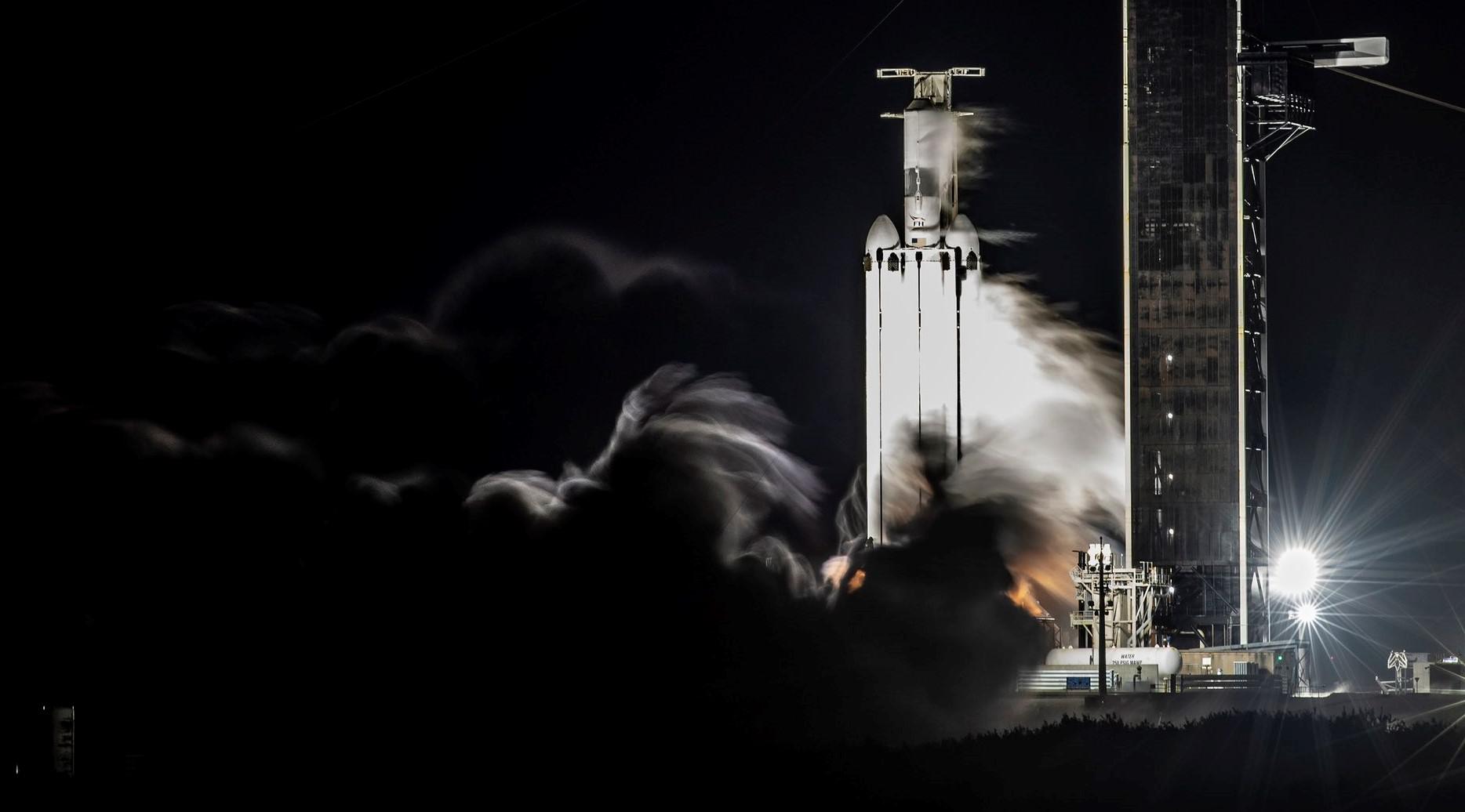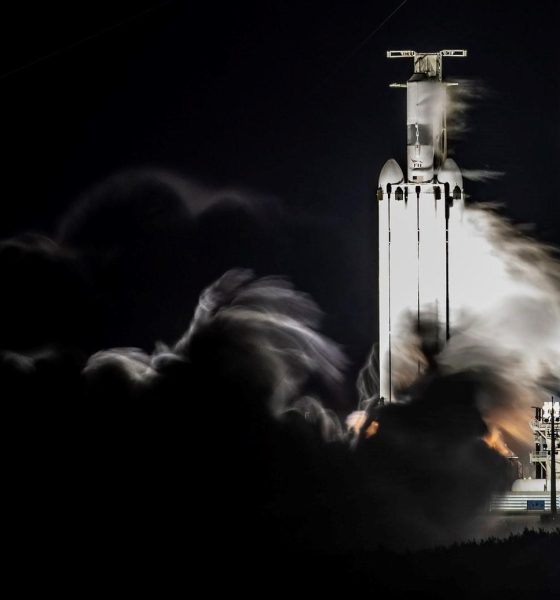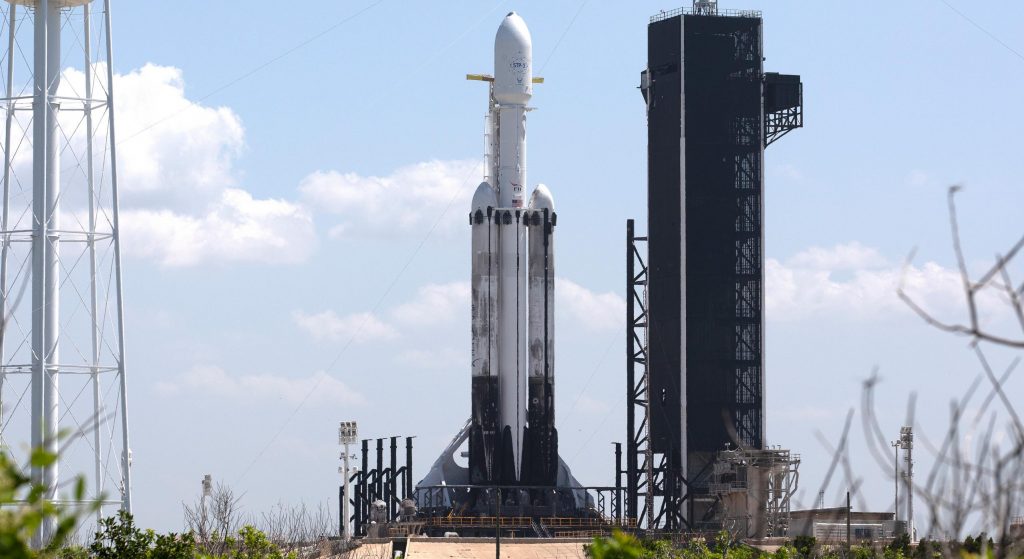

News
SpaceX Falcon Heavy rocket passes static fire test three years in the making
After knocking out some figurative cobwebs, SpaceX has test-fired a Falcon Heavy rocket for the first time since June 2019.
Shortly before the static fire, NASASpaceflight’s Thomas Burghardt reported that Falcon Heavy’s first launch in 40 months – a mission for the US Space Force known as USSF-44 – had slipped from October 28th and October 31st to no earlier than (NET) 9:40 am EDT (13:40 UTC), Tuesday, November 1st. USSF-44 will be Falcon Heavy’s fourth launch since February 2018.
During its 10-second October 27th static fire, Falcon Heavy – the most capable rocket currently operational – appeared to ignite all 27 of its first stage’s Merlin 1D engines, likely producing up to 2350 tons (5.18 million lbf) of thrust. Only three liquid-powered rockets (N1, Saturn V, & Energia) and one rocket augmented by solid rocket boosters (the Space Shuttle) have produced more thrust at sea level, and the most recently active of those four vehicles (NASA’s Space Shuttle) was permanently retired in 2011.
NASA’s Space Launch System (SLS) rocket will retake the crown when it (hopefully) debuts later this year, but Falcon Heavy will remain the most powerful commercially-available rocket until SpaceX’s own Starship debuts. After Starship debuts later this year or early next, Falcon Heavy will continue on as the second most powerful commercial rocket for the indefinite future.
After more than three years of downtime, SpaceX unsurprisingly appeared to run into minor issues while preparing Falcon Heavy for a full wet dress rehearsal and static fire. SpaceX rolled the rocket – sans payload fairing – out to the launch pad late on October 25th, at which point the launch target had already slipped to October 31st. Falcon Heavy then sat horizontally for about 30 hours before SpaceX raised it vertical and fully attached the rocket and transporter/erector to the pad’s ground systems.
Another 12 hours of work later, SpaceX was ready to begin static fire test operations, and Falcon Heavy fired up at 8 pm EDT on October 27th, 50 hours after it rolled out. During Falcon 9’s most recent satellite launch out of Pad 39A, the rocket lifted off about 30 hours after rollout. While preparing for Falcon Heavy Block 5’s first launch (Flight 2 overall) in April 2019, the rocket went vertical 12 hours after rollout – 18 hours faster than Flight 4. Ahead of Flight 3 in June 2019, Falcon Heavy completed a static fire test 25 hours after rolling out – 25 hours faster than Flight 4.


Before it can launch, Falcon Heavy will have to return to LC-39A’s hangar to have its fairing (containing two classified USSF-44 satellites) installed and then return to the pad, repeating the rollout process. Falcon Heavy Flight 3 holds the record (5d 4h) for the shortest gap between a static fire and launch. Falcon Heavy’s updated launch target is 4 days and 14 hours after its static fire, meaning that SpaceX will have to break that record to launch USSF-44 as planned.
Update: The USSF-44 payload fairing – satellites safely encapsulated inside it – headed to Pad 39A less than four hours after Falcon Heavy Flight 4’s static fire.
Regardless, with a successful static fire under its belt, Falcon Heavy’s fourth launch is now all but guaranteed to occur within the next 5-10 days. The rocket’s fifth launch – carrying ViaSat’s first ViaSat-3 communications satellite – could follow as early as December 2022, and another four Falcon Heavy launches are currently scheduled between January and August 2023.

News
Tesla FSD fleet is nearing 7 billion total miles, including 2.5 billion city miles
As can be seen on Tesla’s official FSD webpage, vehicles equipped with the system have now navigated over 6.99 billion miles.

Tesla’s Full Self-Driving (Supervised) fleet is closing in on almost 7 billion total miles driven, as per data posted by the company on its official FSD webpage.
These figures hint at the massive scale of data fueling Tesla’s rapid FSD improvements, which have been quite notable as of late.
FSD mileage milestones
As can be seen on Tesla’s official FSD webpage, vehicles equipped with the system have now navigated over 6.99 billion miles. Tesla owner and avid FSD tester Whole Mars Catalog also shared a screenshot indicating that from the nearly 7 billion miles traveled by the FSD fleet, more than 2.5 billion miles were driven inside cities.
City miles are particularly valuable for complex urban scenarios like unprotected turns, pedestrian interactions, and traffic lights. This is also the difference-maker for FSD, as only complex solutions, such as Waymo’s self-driving taxis, operate similarly on inner-city streets. And even then, incidents such as the San Francisco blackouts have proven challenging for sensor-rich vehicles like Waymos.
Tesla’s data edge
Tesla has a number of advantages in the autonomous vehicle sector, one of which is the size of its fleet and the number of vehicles training FSD on real-world roads. Tesla’s nearly 7 billion FSD miles then allow the company to roll out updates that make its vehicles behave like they are being driven by experienced drivers, even if they are operating on their own.
So notable are Tesla’s improvements to FSD that NVIDIA Director of Robotics Jim Fan, after experiencing FSD v14, noted that the system is the first AI that passes what he described as a “Physical Turing Test.”
“Despite knowing exactly how robot learning works, I still find it magical watching the steering wheel turn by itself. First it feels surreal, next it becomes routine. Then, like the smartphone, taking it away actively hurts. This is how humanity gets rewired and glued to god-like technologies,” Fan wrote in a post on X.
News
Tesla starts showing how FSD will change lives in Europe
Local officials tested the system on narrow country roads and were impressed by FSD’s smooth, human-like driving, with some calling the service a game-changer for everyday life in areas that are far from urban centers.

Tesla has launched Europe’s first public shuttle service using Full Self-Driving (Supervised) in the rural Eifelkreis Bitburg-Prüm region of Germany, demonstrating how the technology can restore independence and mobility for people who struggle with limited transport options.
Local officials tested the system on narrow country roads and were impressed by FSD’s smooth, human-like driving, with some calling the service a game-changer for everyday life in areas that are far from urban centers.
Officials see real impact on rural residents
Arzfeld Mayor Johannes Kuhl and District Administrator Andreas Kruppert personally tested the Tesla shuttle service. This allowed them to see just how well FSD navigated winding lanes and rural roads confidently. Kruppert said, “Autonomous driving sounds like science fiction to many, but we simply see here that it works totally well in rural regions too.” Kuhl, for his part, also noted that FSD “feels like a very experienced driver.”
The pilot complements the area’s “Citizen Bus” program, which provides on-demand rides for elderly residents who can no longer drive themselves. Tesla Europe shared a video of a demonstration of the service, highlighting how FSD gives people their freedom back, even in places where public transport is not as prevalent.
What the Ministry for Economic Affairs and Transport says
Rhineland-Palatinate’s Minister Daniela Schmitt supported the project, praising the collaboration that made this “first of its kind in Europe” possible. As per the ministry, the rural rollout for the service shows FSD’s potential beyond major cities, and it delivers tangible benefits like grocery runs, doctor visits, and social connections for isolated residents.
“Reliable and flexible mobility is especially vital in rural areas. With the launch of a shuttle service using self-driving vehicles (FSD supervised) by Tesla in the Eifelkreis Bitburg-Prüm, an innovative pilot project is now getting underway that complements local community bus services. It is the first project of its kind in Europe.
“The result is a real gain for rural mobility: greater accessibility, more flexibility and tangible benefits for everyday life. A strong signal for innovation, cooperation and future-oriented mobility beyond urban centers,” the ministry wrote in a LinkedIn post.
News
Tesla China quietly posts Robotaxi-related job listing
Tesla China is currently seeking a Low Voltage Electrical Engineer to work on circuit board design for the company’s autonomous vehicles.

Tesla has posted a new job listing in Shanghai explicitly tied to its Robotaxi program, fueling speculation that the company is preparing to launch its dedicated autonomous ride-hailing service in China.
As noted in the listing, Tesla China is currently seeking a Low Voltage Electrical Engineer to work on circuit board design for the company’s autonomous vehicles.
Robotaxi-specific role
The listing, which was shared on social media platform X by industry watcher @tslaming, suggested that Tesla China is looking to fill the role urgently. The job listing itself specifically mentions that the person hired for the role will be working on the Low Voltage Hardware team, which would design the circuit boards that would serve as the nervous system of the Robotaxi.
Key tasks for the role, as indicated in the job listing, include collaboration with PCB layout, firmware, mechanical, program management, and validation teams, among other responsibilities. The role is based in Shanghai.
China Robotaxi launch
China represents a massive potential market for robotaxis, with its dense urban centers and supportive policies in select cities. Tesla has limited permission to roll out FSD in the country, though despite this, its vehicles have been hailed as among the best in the market when it comes to autonomous features. So far, at least, it appears that China supports Tesla’s FSD and Robotaxi rollout.
This was hinted at in November, when Tesla brought the Cybercab to the 8th China International Import Expo (CIIE) in Shanghai, marking the first time that the autonomous two-seater was brought to the Asia-Pacific region. The vehicle, despite not having a release date in China, received a significant amount of interest among the event’s attendees.








